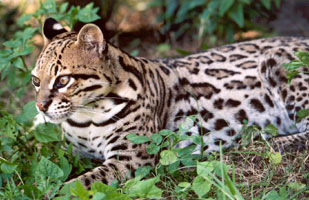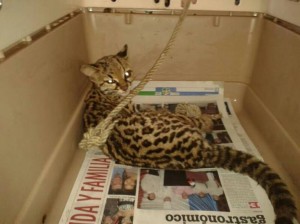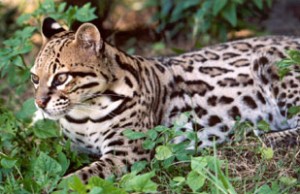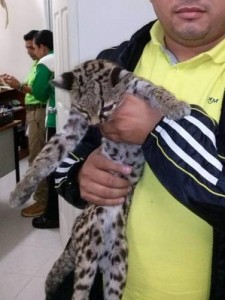
Cozumel News An Ocelot Lost
An Ocelot was found in Cozumel. The papers, Facebook and radio were buzzing early last week with reports of a captured Ocelot on the island. Ocelots are not native to the island, and no one knows how it got here. It was discovered on Felix Gonzalez Canto by the entrance to Colonia Miraflores. A Ms.Paola Llena reported the ocelot entered her yard and killed her duck and two rabbits around four in the morning. Ms. Llena’s brother set a trap and successfully trapped the ocelot unharmed by six that very morning. The Ocelot was given to the fire department, who in turn contacted the Department of Ecology who would plan the ocelot’s safe release as it is a protected species. There is no Attorney on the island representing the Environmental Protection Agency that would have normally investigated trafficking of this endangered species.

Misc: This cat is probably the best known of the South American cats because of its pelt being the mainstay of the fur trade, and for the fact that it was frequently kept as a pet. Due the fact that Ocelots are high strung, unpredictable, comedic little cats, humans de-fanged, de-clawed, de-scented, and altered these cats in order to make them conform to the “pet” industry. Like all exotic cats, these creatures, male or female, altered or not, spray a foul smelling urine on everything they wish to mark as theirs including their keepers. In the 1980’s, Ocelot fur coats sold for $40,000.00 and the live animal as a pet sold for $800.00. At one time, more than 200,000 ocelots per year were killed for their coats. Today, with laws prohibiting hunting for the fur trade, there are no Ocelot coats for sale, and the “pet” Ocelot is a thing of the past.
Habitat: The Ocelot is found in very diverse habitats including rain forest, montane forest, thick bush, semi-deserts, coastal marsh, and along river banks, but it is never found in open country.
Distribution: Southern Texas, and every country south of the U.S. except Chile.
Reproduction and Offspring: After a gestation of 79-85 days they produce a litter of 1-2 young. They weigh approximately 8.5 ounces at birth. The females reach maturity at around 1½ years, and around 2 ½ years for males. They become independent at around 1 year of age, but seem to be tolerated in their natal range for up to another year.
Social System and Communication: Ocelots are solitary and territorial. The females defend their exclusive territory, which can be as much as 9 sq. miles, while the male’s territory is larger and overlaps that of 1 or more females (can be as large as 35 sq. miles). Ocelots communicate by use of scent markings which tells the males when she is ready for mating and by vocal communications such as meows and yowls (in heat). Hear our purrs, hisses, snarls, calls, and growl sounds HERE
Hunting and Diet: The Ocelot is a terrestrial hunter and active during the night (nocturnal), and the mainstay of its diet are nocturnal rodents, such as cane mice, and marsh, spiny and rice rats, opossums and armadillos. They will also take larger prey such as lesser anteaters, deer, squirrel monkeys and land tortoises. They will also take advantage of seasonal changes and the abundance of fish and land crabs during the wet season. Occasionally, they will take birds and reptiles. However, the majority of prey items for this cat weigh less than 1-3% of its body weight.
Principal Threats: Ocelots have a small litter size, one of the longest gestation and growth rates among the small felids, and a high infant mortality rate. Add this difficulty in sustaining its own population with deforestation and habitat destruction, and the survival of this beautiful little species becomes even more difficult.
Felid TAG recommendation: Ocelot (Leopardus pardalis). Although once commonly imported for pets, legal animals have not been available until the last 2 years, and today most ocelots are of unknown or hybrid ancestry. The TAG is recommending that the Brazilian ocelot, L. p. mitis, be the subspecies acquired by North American zoos because captive propagation now is occurring in some Brazilian zoos. Orphaned individuals also have been allowed to be exported. Recently three pairs were imported into North America by AZA zoos. The target population of this species is 120 individuals. Although only a PMP is in operation, the TAG recommends that it be upgraded to SSP status as soon as possible. The Brazilian Ocelot Consortium is the main focus for saving the ocelot.
How rare is this cat? The International Species Information Service lists 217 worldwide, with 108 being in the U.S.








